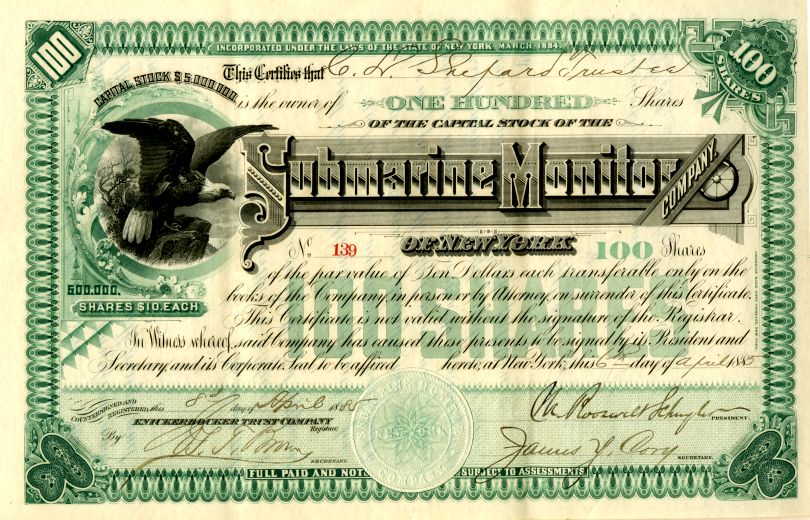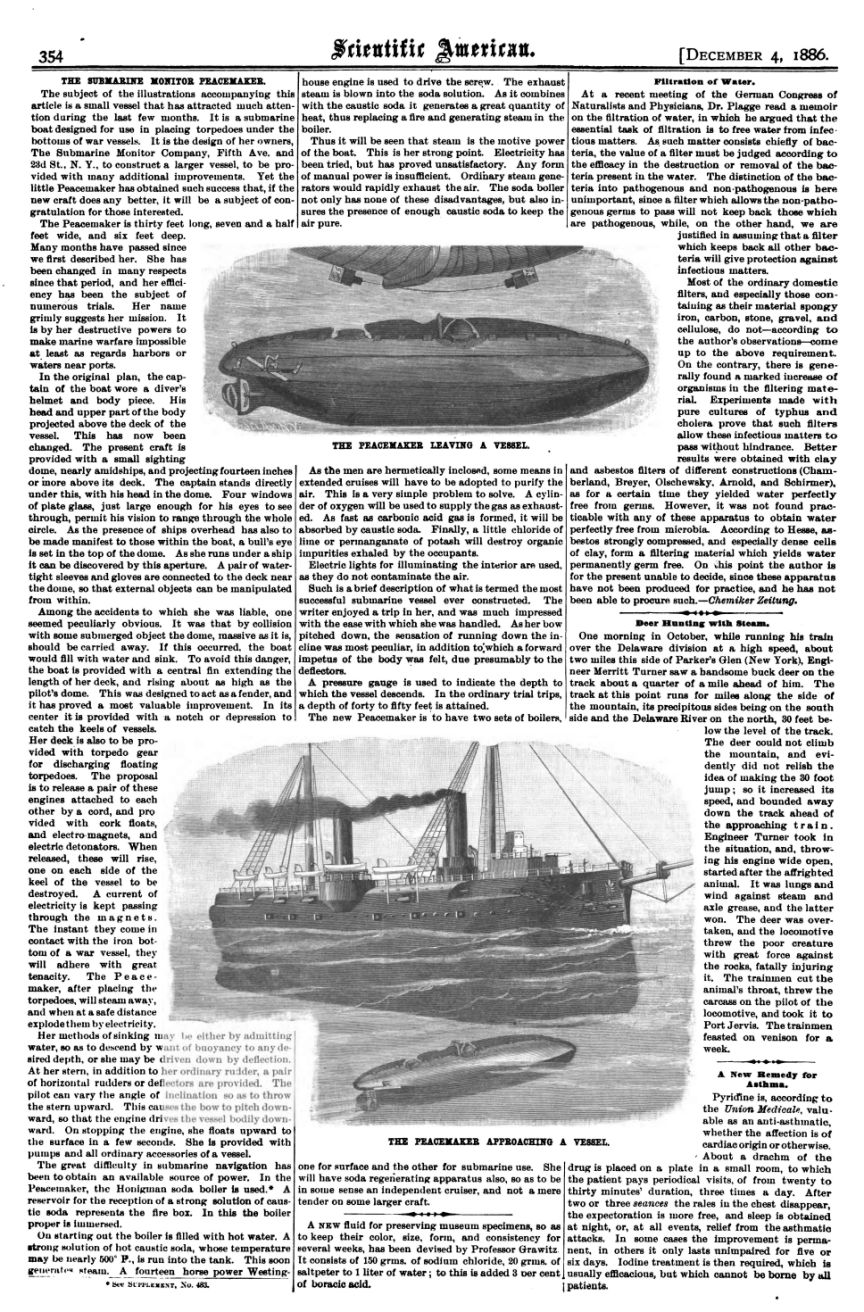Beautifully engraved specimen certificate from the Submarine Monitor Company of New York issued in 1885. This historic document was printed by the American Banknote Company and has an ornate border around it with a vignette of an eagle and the company's name. This item has been hand signed by the Company's officers. 
Certificate 
Scientific American Article 1886 THE SUBMARINE MONITOR PEACEMAKER. The subject of the illustrations accompanying this article is a small vessel that has attracted much attention during the last few months. It is a submarine boat designed for use in placing torpedoes under the bottoms of war vessels. It is the design of her owners, The Submarine Monitor Company, Fifth Ave. and 23d St., N. Y., to construct a larger vessel, to be provided with many additional improvements. Yet the little Peacemaker has obtained such success that, if the new craft does any better, it will be a subject of congratulation for those interested. The Peacemaker is thirty feet long, seven and a half feet wide, and six feet deep. Many months have passed since we first described her. She has been changed in many respects since that period, and her efficiency has been the subject of numerous trials. Her name grimly suggests her mission. It is by her destructive powers to make marine warfare impossible at least as regards harbors or waters near ports. In the original plan, the captain of the boat wore a diver's helmet and body piece. His head and upper part of the body projected above the deck of the vessel. This has now been changed. The present craft is provided with a small sighting dome, nearly amidships, and projecting fourteen inches or inore above its deck. The captain stands directly under this, with his head in the dome. Four windows of plate glass, just large enough for his eyes to see through, permit his vision to range through the whole circle. As the presence of ships overhead has also to be made manifest to those within the boat, a bull's eye is set in the top of the dome. As she runs under a ship it can be discovered by this aperture. A pair of watertight sleeves and gloves are connected to the deck near the dome, so that external objects can be manipulated from within. Among the accidents to which she was liable, one seemed peculiarly obvious. It was that by collision with some submerged object the dome, massive as it is, should be carried away. If this occurred, the boat would fill with water and sink. To avoid this danger, the boat is provided with a central fin extending the length of her deck, and rising about as high as the pilot's dome. This was designed to act as a fender, and it has proved a most valuable improvement. In its center it is provided with a notch or depression to catch the keels of vessels. Her deck is also to be provided with torpedo gear for discharging floating torpedoes. The proposal is to release a pair of these engines attached to each other by a cord, and pro vided with cork floats, and electromagnets, and electric detonators. When released, these will rise, one on each side of the keel of the vessel to be destroyed. A current of electricity is kept passing through the magnets. The instant they come in contact with the iron bottom of a war vessel, they will adhere with great tenacity. The Peacemaker, after placing the torpedoes, will steam away, and when at a safe distance explode them by electricity. Her methods of sinking may be eit her by admitting water, so as to descend by want of buoyancy to any desired depth, or she may be driven down by deflection. At her stern, in addition to her ordinary rudder, a pair of horizontal rudders or deflectors are provided. The pilot can vary the angle of inclination so as to throw the stern upward. This causes the bow to pitch downward, so that the engine drive- t In- vessel bodily downward. On stopping the engine, she floats upward to the Burface in a few seconds. She is provided with pumps and all ordinary accessories of a vessel. The great difficulty in submarine navigation has been to obtain an available source of power. In the Peacemaker, the Honiguian soda boiler is used.* A reservoir for the reception of a strong solution of caustic soda represents the fire box. In this the boiler proper is immersed. On starting out the boiler is filled with hot water. A ·trong solution of hot caustic soda, whose temperature may be nearly 500° P., is run into the tank. This soon generates steam. A fourteen horse power Westinghouse engine is used to drive the screw. The exhaust steam is blown into the soda solution. As it combines with the caustic soda it generates a great quantity of heat, thus replacing an arc and generating steam in the boiler. Thus it will be seen that steam is the motive power of the boat. This is her strong point. Electricity has been tried, but has proved unsatisfactory. Any form of manual power is insufficient. Ordinary steam generators would rapidly exhaust the air. The soda boiler not only has none of these disadvantages, but also insures the presence of enough caustic soda to keep the air pure. THE PEACEMAKER LEAVING A VESSEL. As the men are hermetically inclosed, some means in extended cruises will have to be adopted to purify the air. This is a very simple problem to solve. A cylinder of oxygen will be used to supply the gas as exhausted. As fast as carbonic acid gas is formed, it will be absorbed by caustic soda. Finally, a little chloride of lime or permanganate of potash will destroy organic impurities exhaled by the occupants. Electric lights for illuminating the interior are used, as they do not contaminate the air. Such is a brief description of what is termed the most successful submarine vessel ever constructed. The writer enjoyed a trip in her, and was much impressed with the ease with which she was handled. As her bow pitched down, the sensation of running down the incline was most peculiar, in addition to/which a forward impetus of the body was felt, due presumably to the deflectors. A pressure gauge is used to indicate the depth to which the vessel descends. In the ordinary trial trips, a depth of forty to fifty feet is attained. The new Peacemaker is to have two sets of boilers, one for surface and the other for submarine use. She will have soda regenerating apparatus also, so as to be in some sense an independent cruiser, and not a mere tender on some larger craft. History from Encyberpedia and OldCompany.com (old stock certificate research service)

Certificate

Scientific American Article 1886










